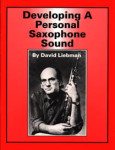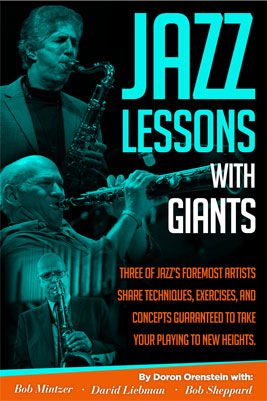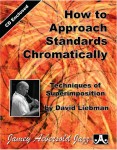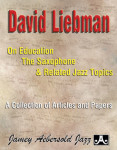 Compiled by one of Liebman’s protegees, saxohonist Matt Vashlishan, this is a pocket guide to he basics of saxophone playing, a kind of condensed version of Liebman’s historic treatise on the subject “Developing A Personal Saxophone Sound” (Dorn Publications). Able to be carried around easily, there is a very good review of all the required and advanced overtone exercises, considered the cornerstone of understanding saxophone principles.
Compiled by one of Liebman’s protegees, saxohonist Matt Vashlishan, this is a pocket guide to he basics of saxophone playing, a kind of condensed version of Liebman’s historic treatise on the subject “Developing A Personal Saxophone Sound” (Dorn Publications). Able to be carried around easily, there is a very good review of all the required and advanced overtone exercises, considered the cornerstone of understanding saxophone principles.
Books
A CHROMATIC APPROACH TO JAZZ HARMONY AND MELODY(WITH CD) – DAVID LIEBMAN
This book should be seen as a method to help the artist to develop his or her own way when trying to improvise chromatically. Through the concepts and examples offered, the improviser should be able to use this material alongside already familiar tonal ideas. Specifically, the book serves as a guide for organizing chromaticism into a coherent musical statement meant to satisfy both the intellectual and emotional needs of artistic creation. The reader will be introduced to more than one way of conceiving chromatic lines and harmonies. There is nothing theoretically complex or new in the text, it is the organization of the material as well as many musical examples and transcriptions (Bach, Scriabin, Coltrane, Shorter, Hancock, Beirach, Liebman plus others) which should serve to inspire musicians to expand their usual diatonic vocabulary. This book also provides insight into the style of playing that David Liebman is known for. In addition the book contains 100 assorted solo lines and 100 chord voicings.
“To me this book is one of the most fascinating and illuminating books ever written on the subject of improvisation. The first day after I got it I practiced with it for about six hours straight. I love the way it just sort of opens up your mind to look at harmony in such varied ways. All of the musical examples are stimulating, and Dave’s essay on related topics are as elegant and insightful as anything I’ve ever read about improvised music. For musicians looking to expand their harmonic and melodic vocabularies, this is the book! Congratulations!” (Pat Metheny).
DEVELOPING A PERSONAL SAXOPHONE SOUND
 (Available in German, Japanese, Italian, Chinese, Czech and French)
(Available in German, Japanese, Italian, Chinese, Czech and French)
Book for all Saxophonists
This book describes the physiology of sound production and the mechanics involved. The emphasis is upon freeing up the involved muscles and parts of the body so that they can operate in a natural instinctive manner. With these difficulties alleviated, the aspiring saxophonist has the opportunity to find his/her own inner voice. Including diagrams and exercises, this material represents Lieb’s personal interpretation of the studies he did with master teacher Joe Allard.
“This book would be an important and valuable addition to any teacher’s library.”
– Saxophone Journal
SELF PORTRAIT OF A JAZZ ARTIST
For All Musicians and Jazz Listeners
This book focuses on the process of being a jazz artist. Written from the creator’s perspective, the book covers subjects that jazz musicians frequently discuss amongst themselves including creating the music as well as insightful observations on the jazz scene itself. Liebman meticulously discusses soloing, the role of the sideman, the recording studio, leading a group, practicing, as well as other related topics.
Jazz Lessons with Giants
 In this one-of-a-kind highly-acclaimed and popular digital learning program, three of the world’s foremost jazz musicians share their most powerful “insider” secrets on what it is they did to achieve mastery in the art of jazz. Jazz giants, David Liebman, Bob Mintzer, and Bob Sheppard share results-producing techniques and concepts, which, if put to practice, will undoubtedly result in massive strides in areas such as creating compelling melodies, super-charging your ears, using advanced harmony to get that hip, “post-Coltrane” sound, using articulation and phrasing to come up with your own style, and many, many other exciting areas of jazz musicianship. Come see why this program has ignited a spark within so many jazz musicians at all levels, from beginners to seasoned pros.
In this one-of-a-kind highly-acclaimed and popular digital learning program, three of the world’s foremost jazz musicians share their most powerful “insider” secrets on what it is they did to achieve mastery in the art of jazz. Jazz giants, David Liebman, Bob Mintzer, and Bob Sheppard share results-producing techniques and concepts, which, if put to practice, will undoubtedly result in massive strides in areas such as creating compelling melodies, super-charging your ears, using advanced harmony to get that hip, “post-Coltrane” sound, using articulation and phrasing to come up with your own style, and many, many other exciting areas of jazz musicianship. Come see why this program has ignited a spark within so many jazz musicians at all levels, from beginners to seasoned pros.
MASTER LESSONS FOR THE CREATIVE MUSICIAN
 by Bruce Mishkit
by Bruce Mishkit
(Formerly Sax/Flute Lessons With The Greats)
90 plus pages of exercises, etudes, and transcriptions.
A one-of-a-kind book/audio package
filled with musical examples and a wealth of
professional insight and advice.
Includes an audio CD with lesson examples
played by the artists.
“I have found this book to be highly informative and very enjoyable. Along with the accompanying CD, it’s great for any musician interested in improving
their playing.”
-Michael Brecker
“I thoroughly enjoyed it! A valuable asset to the student who would otherwise not have an opportunity to get to know the inner thoughts of these great players.”
-Eddie Daniels
HOW TO APPROACH STANDARDS CHROMATICALLY: TECHNIQUES OF SUPERIMPOSITION
 Using established standard songs from previous Aebersold Play-Alongs, Lieb uses one superimposition technique per tune as described in his Chromatic Approach to Jazz Melody and Harmony to demonstrate how common progressions can be interpreted in a chromatic manner. Several transcriptions of the solos are included, done by Matt Vashlishan, as well as a CD with all of Lieb’s solos.
Using established standard songs from previous Aebersold Play-Alongs, Lieb uses one superimposition technique per tune as described in his Chromatic Approach to Jazz Melody and Harmony to demonstrate how common progressions can be interpreted in a chromatic manner. Several transcriptions of the solos are included, done by Matt Vashlishan, as well as a CD with all of Lieb’s solos.
DAVID LIEBMAN WRITES ON EDUCATION, THE SAXOPHONE, AND RELATED JAZZ TOPICS
Here is a masterful collection of articles and papers David has written over the years summarizing thoughts on various topics related to jazz and education. Each article is a worthy testament unto itself, but as a collection, they form an enlightening and insightful tool for every music educator and player in search of new ideas and fresh perspectives on teaching for the next century.
“A collection of articles and papers written over the years, this collection is a great resource representing a wealth of important contributions made by the author through his jazz education pursuits. I particularly like the author’s treatises on tone, breathing, transciribing, time and jazz rhythms. It is more than just technical information. The author really gets into basic conepts for the beginning saxophonist by analyzing essential ideas that are a must for jazz education instruction. Going beyond the basics, the author also gets into scales, articulation, listening, imitation, sound, breathing, physical warm ups, ear training, reading and philosophy. The collection is strongly recommended for both saxiphonists and music educators. The articles and papers are very relevant for today’s jazz education market.” — IAJE Journal








